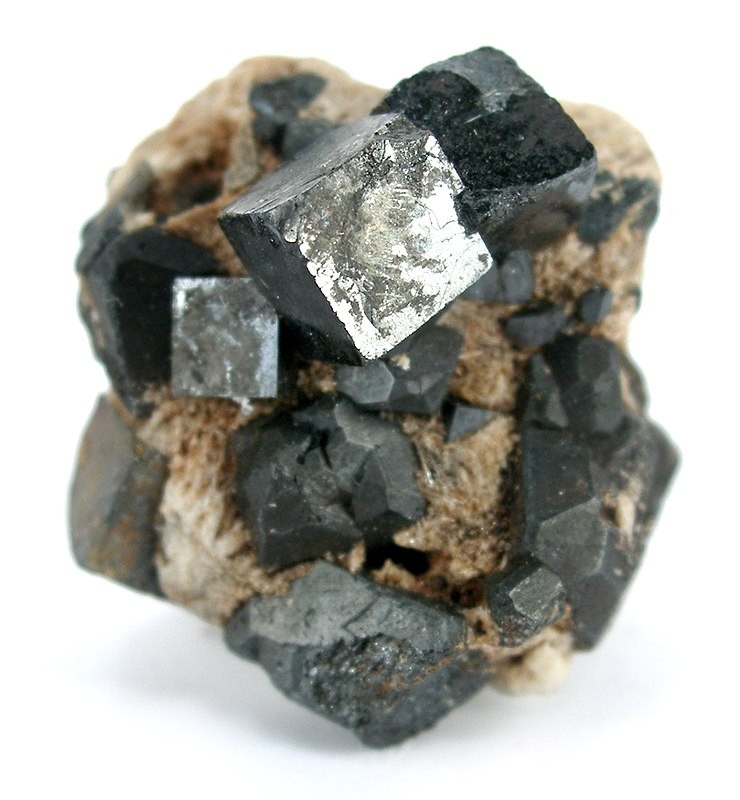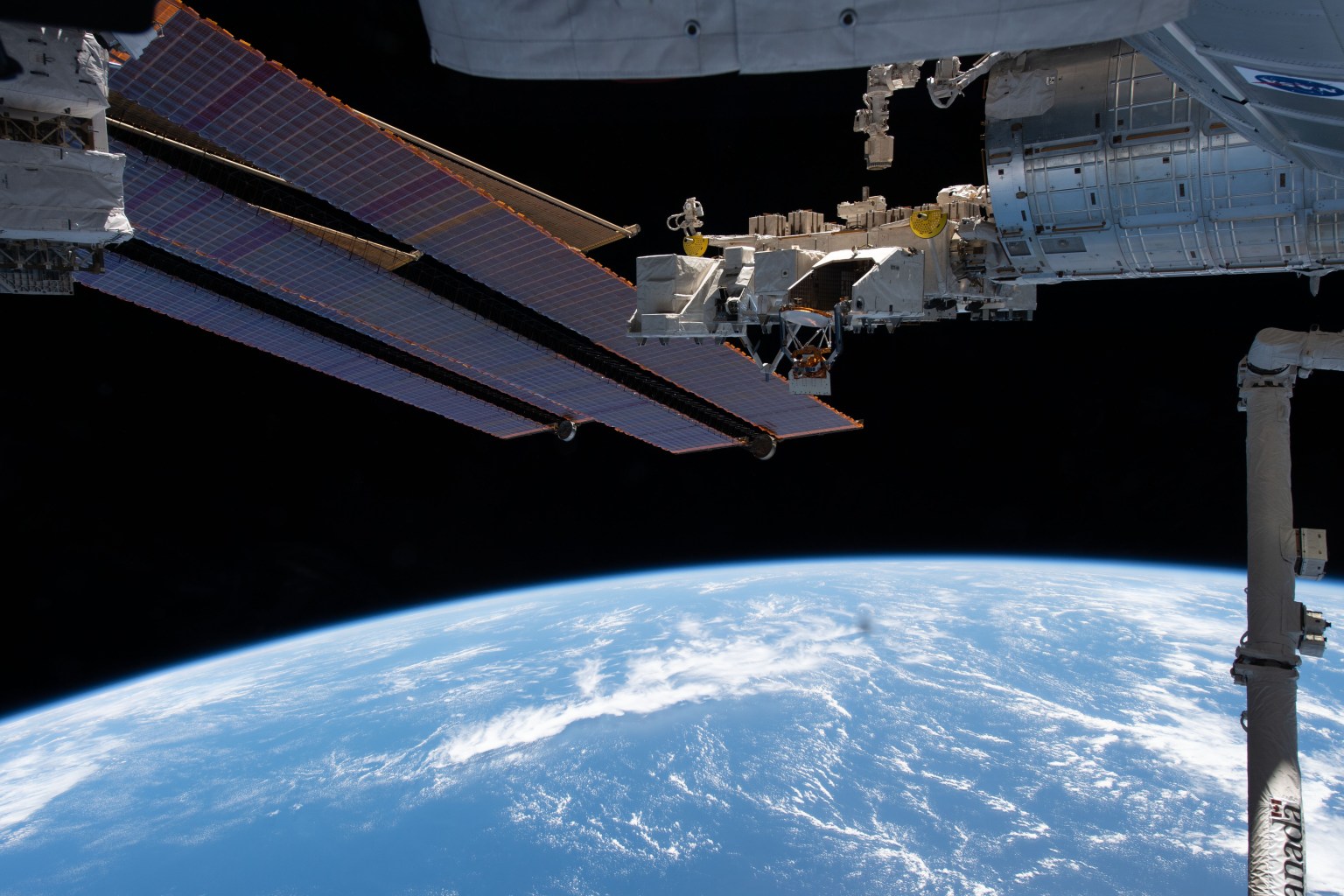
How NASA Uses and Improves Solar Power
The Sun is the most energetic object in our solar system.
Humans have been finding creative ways to harness the Sun's heat and light for thousands of years. But the practice of converting the Sun’s energy into electricity — what we now call solar power — is less than 200 years old. Yet in that short time, solar power has revealed the Sun’s limitless potential to power an increasingly technological society. Since the 1950s, NASA has harnessed the energy of the Sun to power spacecraft and drive scientific discovery across our solar system. Today, NASA continues to advance solar panel technology and test new innovations.
Video credit: NASA's Goddard Space Flight Center/Lacey Young
A Brief History of Solar Power
-
Even before the light bulb, scientists had inklings of the power locked up in a ray of sunlight.
In 1839, French scientist Alexandre Edmond Becquerel (who was 19 at the time) was working in his father’s laboratory, experimenting with two metal sheets placed in an electricity-conducting liquid. As he shined light on the device, he detected a weak electric current — what we now know to be a flow of electrons through the material. This phenomenon was the first demonstration that light could generate electricity, known today as the photovoltaic effect.
 A portrait of French scientist Alexandre Edmond Becquerel, taken sometime in the mid 1800s.Public Domain
A portrait of French scientist Alexandre Edmond Becquerel, taken sometime in the mid 1800s.Public Domain -
In 1872, scientists discovered the first solid material — selenium — that could pass an electrical current.
By 1884 selenium had been incorporated in the world’s first solar array, which was installed on a New York City rooftop. Scientists continued to develop and experiment with selenium and other photovoltaic materials for the next 70 years, but practical applications were limited by their low efficiency – only about 1% of light energy could be converted to electricity.
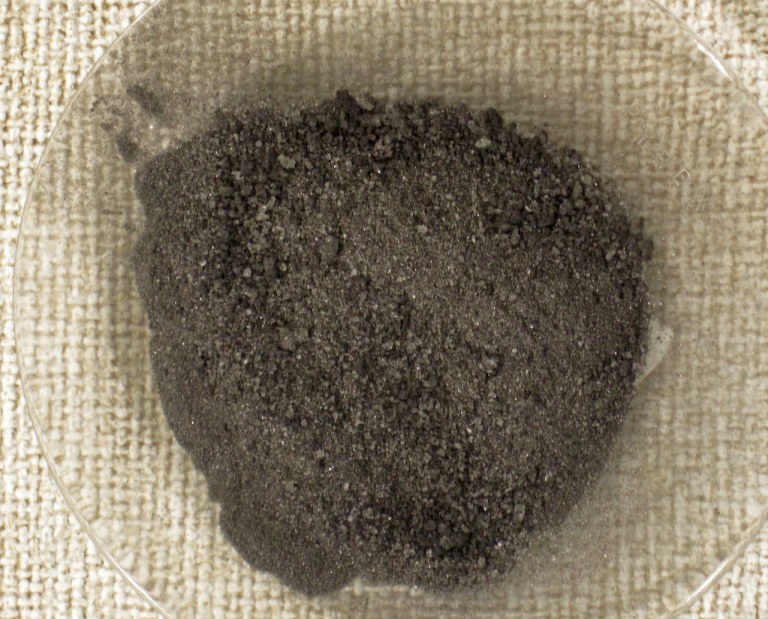 Selenium from Colorado, USA. (public display, Montana Bureau of Mines and Geology Mineral Museum, Butte, Montana, USA), https://creativecommons.org/licenses/by/2.0/
Selenium from Colorado, USA. (public display, Montana Bureau of Mines and Geology Mineral Museum, Butte, Montana, USA), https://creativecommons.org/licenses/by/2.0/ -
A breakthrough came in 1954.
That's when scientists at Bell Labs used an abundant material called silicon to create the first solar cell that achieved 6% efficiency. Solar panels today use this same basic design, with adjustments that have allowed industrial and commercial solar panels to achieve between 15% and 23% efficiency.
 NASA
NASA
How Solar Panels Work
Silicon is an abundant material used in many technological applications because it is a very good “semiconductor,” or material whose ability to carry electric current can be easily manipulated by adding energy. In typical solar cells, silicon is layered in three thin sheets. A middle layer is made of pure silicon. The outer two silicon layers are injected with other elements (typically phosphorous on one side, and boron on the other) that differ in their capacity to “donate” or “accept” electrons. As light strikes the pure silicon layer, it energizes the silicon’s electrons, which then begin to move within the material. Those electrons are attracted to the silicon layer designed to “accept” electrons, leading to a buildup of negative and positive charges in the outer layers. These two sides are then connected with wires to form a circuit that facilitates the flow of electrons from one side to the other, generating usable power.
Silicon-based solar cells power many of NASA’s spacecraft, including the James Webb Space Telescope. Learn more about why this abundant material is used in solar panels in this excerpt from NASA’s Elements of Webb video series.
Credit: NASA's Goddard Space Flight Center
Solar Power in Space
-
A mere four years after the first viable solar cells were created, they made their way to space.
The Soviet Union kicked off the space race with the launch of Sputnik on Oct. 4, 1957, quickly followed by the United States’ Explorer 1 on Jan. 31, 1958. But as both satellites ran exclusively on battery power, they were dead within a few weeks. In March 1958, the United States launched the first solar-powered spacecraft, Vanguard 1 (pictured at right), which transmitted data for the next six years.
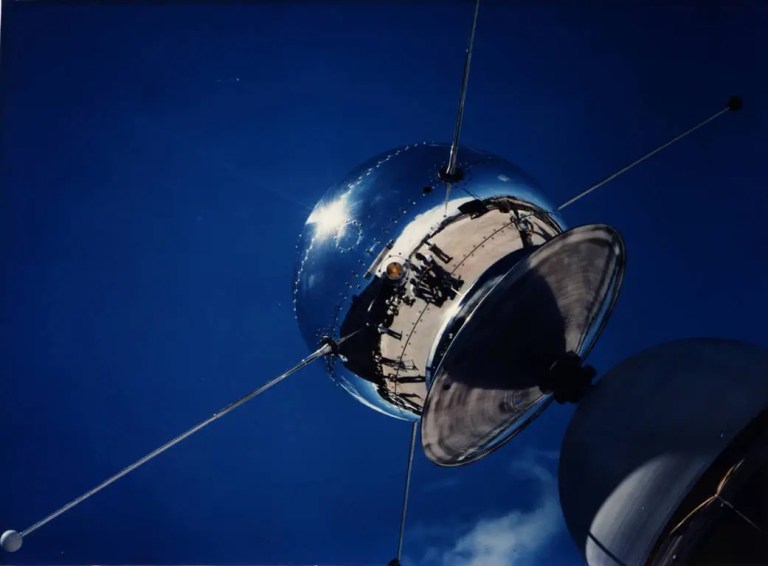 Vanguard 1, the world’s first solar-powered satellite, launched on March 17, 1958.
Vanguard 1, the world’s first solar-powered satellite, launched on March 17, 1958. -
Solar cells became the de facto way to power spacecraft, and remain so today.
Some missions, such as NASA’s Parker Solar Probe, require specialized solar panels that can operate in extreme environments. Flying on an elliptical orbit into the Sun’s hot outer atmosphere, Parker Solar Probe uses solar panels angled away and partially shaded from the Sun. It also uses a special cooling system to ensure the system isn’t overwhelmed by heat and was designed to be extra robust to deal with the intense ultraviolet rays it receives when close to the Sun, which can degrade materials rapidly. The spacecraft’s elliptical orbit also takes it far from the Sun, even beyond Venus. Engineers designed the solar array to compensate for how the light changes at different distances to the Sun, which alters the color and intensity of the sunlight it receives.
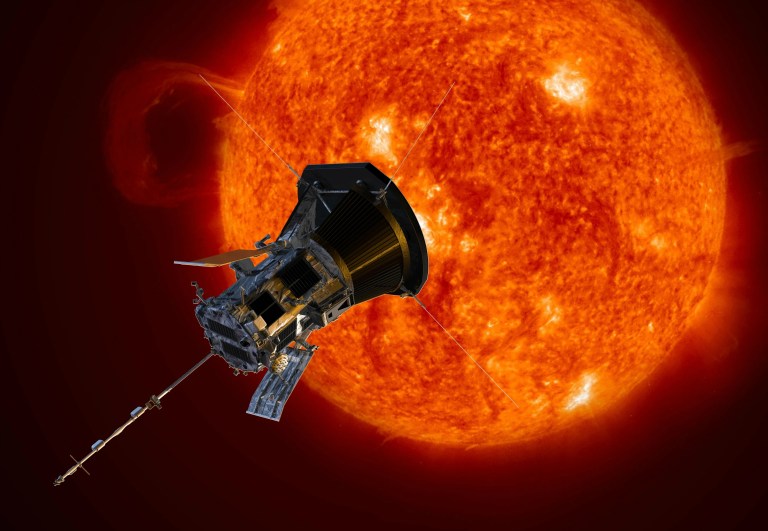 Parker Solar Probe uses remote and direct measurements to collect data about the Sun.NASA
Parker Solar Probe uses remote and direct measurements to collect data about the Sun.NASA -
But sunlight drops dramatically with distance.
At Jupiter, which receives 25 times less light than Earth, the Juno spacecraft (pictured at right) needs three 30-foot-long panels to generate 500 watts of energy — about how much a typical refrigerator uses. Its orbit around Jupiter also helps keep the solar panels almost constantly exposed to sunlight to maximize power generation.
Solar power becomes less viable for missions that venture even farther, where there’s not even enough light to charge a battery. Deep space missions like NASA’s Voyager 1 and 2 rely instead on energy from the radioactive decay of plutonium-238 to keep them running well into interstellar space.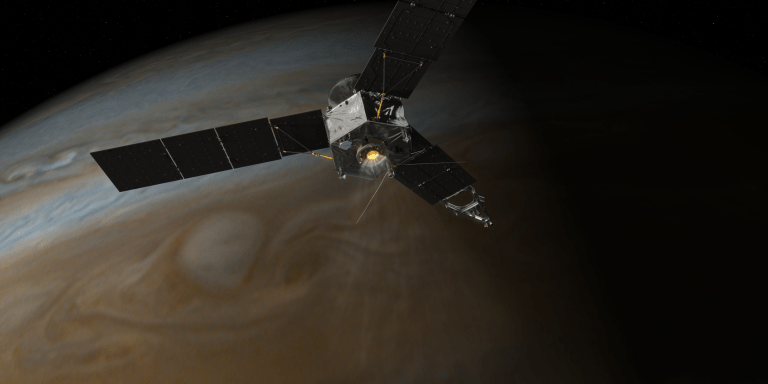
How NASA is Improving Solar Power
Perovskites for Improved Efficiency
NASA scientists and other researchers around the world are working to improve the efficiency and durability of solar panels. In addition to using silicon, scientists have discovered that adding a layer of minerals known as perovskites can dramatically improve panel efficiency. Perovskites help capture bluer visible wavelengths, complimenting silicon’s redder wavelength coverage and allowing a solar cell to capture more light. In 2023, several independent research teams created small perovskite-silicon solar cells that exceeded 30% efficiency, and the best experimental cells today are approaching 50% efficiency.
ROSAs for Flexibility
NASA is also developing technology for flexible and rollable solar panels that can improve their use in constrained spaces. Using different materials for the base layer of a solar panel can make a panel lighter and more flexible — essential attributes for space missions that need to be packed into a small space in a rocket. The first two sets of solar arrays used by NASA’s Hubble Space Telescope in the 1990s and 2000s were designed with solar cells mounted to a flexible blanket-like material so they could be rolled up and stowed to fit inside the space shuttle cargo bay for launch.
In 2009, NASA and its partners started working on the next iteration of flexible solar panels called roll-out solar arrays (ROSAs). These arrays, which unfurl like a roll of paper towels, are even lighter and more affordable than previous arrays. They have been used on NASA’s DART (Double Asteroid Redirection Test) mission, on commercial geostationary satellites, and on the International Space Station to augment its traditional solar array. NASA plans to include ROSAs on Gateway, an orbiting outpost crucial to NASA’s Artemis campaign.
Vertical Arrays for Lunar Applications
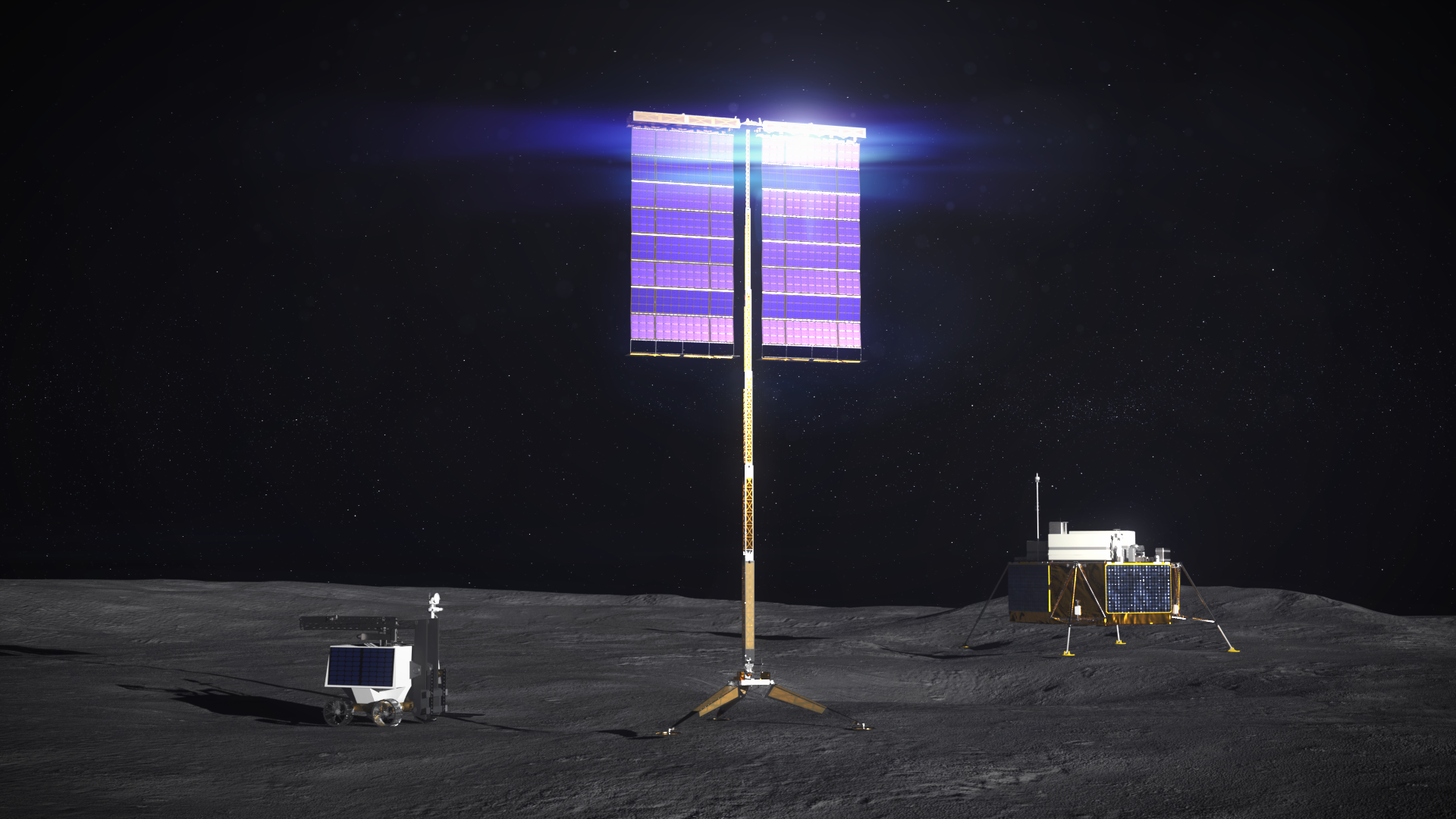
The Future of Solar Power in Space
-
Sailing with the Sun
Along with working to improve the efficiency of solar panels, NASA is also looking beyond photovoltaics to an old technology: sails. Humans have crossed open waters by sail for thousands of years. And now, NASA is working on a system to traverse space using solar sails. Unlike photovoltaics, which work by capturing the energy of light, solar sails use the pressure of light. When a photon, or individual particle of light, bounces off a reflective solar sail, it imparts a small push. With enough photons, these tiny nudges can move an entire spacecraft, much like how traditional sails harness the multitude of tiny air molecules that make up the wind. In the future, solar sails could replace heavy propulsion systems and enable longer-duration and lower-cost missions.
-
The Advanced Composite Solar Sail System
In 2024, the Advanced Composite Solar Sail System, a microwave-sized spacecraft, launched to test a new composite boom — a sail’s framework — made from materials that are stiffer and lighter than previous boom designs. The spacecraft has a solar sail measuring about 860 square feet — about the size of six parking spots. The seven-meter-long boom that holds out the solar sail can collapse into a bundle that would fit in your hand, which allowed it to fit compactly inside the spacecraft. The mission demonstrated the boom’s deployment and is now testing the sail’s performance using a series of maneuvers to adjust the spacecraft orbit using the sail angle. The technology could eventually allow for future sails up to half the size of a soccer field, enabling travel to the Moon, Mars, and beyond.
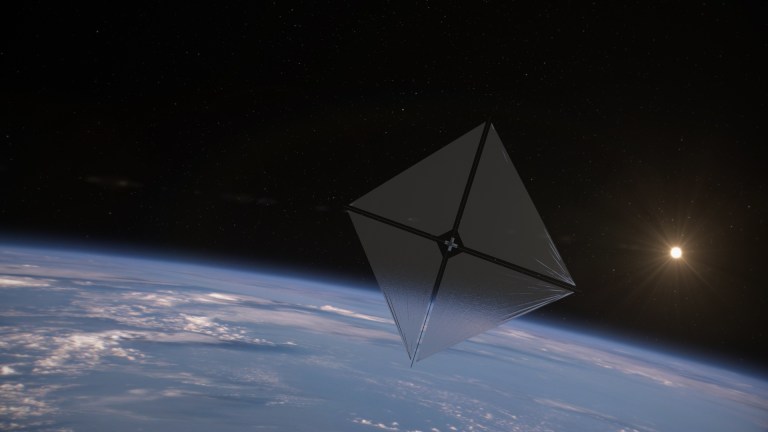
Learn More
Explore NASA's Sun-related stories and download high-resolution images of the solar system, agency missions, and more.

Advanced Composite Solar Sail System (ACS3)
Just as a sailboat is powered by wind in a sail, solar sails employ the pressure of sunlight for propulsion, eliminating the need for conventional rocket propellant.

Oct. 2 Annular Solar Eclipse
On Oct. 2, 2024, the Moon will pass in front of the Sun, casting its shadow across parts of Earth.




























